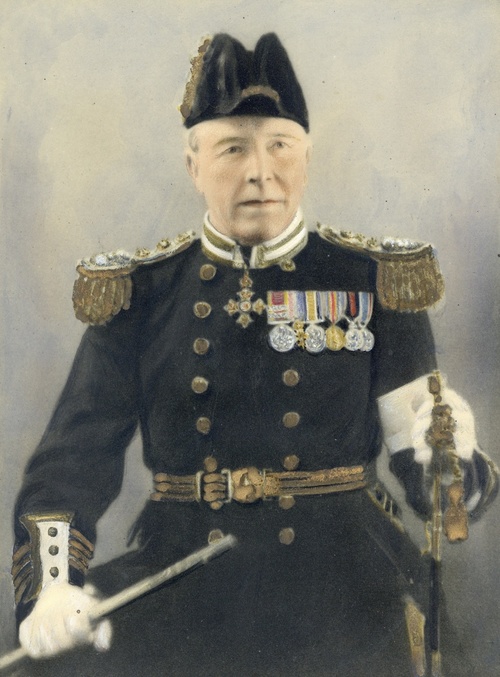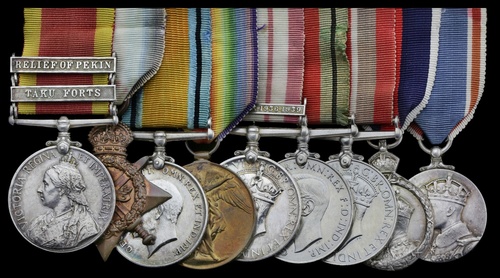Auction: 20001 - Orders, Decorations and Medals - conducted behind closed doors
Lot: 803
A particularly interesting group of nine awarded to Captain C. C. Walcott, Royal Navy, who was mentioned in despatches for services at Tientsin in June 1900 and later became a trusted member of British Naval Intelligence, being responsible for the safe transfer of the 'Black Diaries' to Washington as a means of stifling anti-British sentiment amongst the Irish population in the United States of America
China 1900, 2 clasps, Taku Forts, Relief of Pekin (Act. Lieut. C. C. Walcott. H.M.S. Centurion.); 1914-15 Star (Commr. C. C. Walcott, R.N.); British War and Victory Medals (Commr. C. C. Walcott R.N.); Naval General Service 1915-62, 1 clasp, Palestine 1936-39 (Capt. C. C. Walcott. C.B.E. R.N.); Defence and War Medals 1939-45; Coronation 1902, silver; Coronation 1937, the first a duplicate issue with later impressed naming and fitted with copy clasps, the V.M. officially re-impressed, mounted as worn, good very fine (9)
[C.B.E.] London Gazette 5 June 1920:
'For services in connection with the Imperial War Museum.'
Colpoys Cleland Walcott was born on 31 July 1878 at Maidenhead, the son of Lyons Roden Simpson Walcott, an Irish land agent of 10, Prince of Wales Mansions, Battersea Park. Naval tradition ran in the family through his paternal grandfather, Colpoys Walcott, who served as a Midshipman in the Royal Navy from 5 December 1857 but was discharged dead on 10 June 1861 whilst serving aboard the Victor Emanuel. As a result, Walcott was educated at Eastman's Preparatory School in Southsea which was primarily known at that time as a school which prepared young boys for entry to the Royal Navy.
Sent to Britannia as a Naval Cadet on 15 July 1892, Walcott passed out as Midshipman on 15 January 1895 and served as Sub-Lieutenant aboard Centurian off the coast of China, being present with the Naval Brigade at the capture of the Taku Forts, the defence of Tientsin and the Relief of Pekin. An entry in his service papers notes:
'Commanded a detachment of Centurian's men at the capture of Taku Forts + was present in operations round Tientsin - specially mentioned in despatches, specifically promoted for this service.'
Promoted Lieutenant on 9 November 1900, Walcott received further praise for his fitness, a superior noting 'very good officer, good at gymnastics'. He went on to qualify as a Physical Training Instructor at Aldershot in 1909, whilst also gaining Certificates in seamanship, navigation, torpedo, gunnery and pilotage. At around this time he also came runner-up in the Army & Navy Boxing Championship, being beaten by Colonel Campbell, a Scot of considerable prowess in the ring. The bruising encounter ensured that during the officer's Middleweight Championship held the following November, Walcott looked on as a referee and judge (Sporting Life, 1 November 1912, refers).
Instead, he ploughed his energy at that time into the organisation of the United Services Rugby Club at Portsmouth. Many years later, Walcott recalled an amusing story illustrating the keenness of the players in those days, as published in the Hampshire Telegraph in 1925:
'In reply to the useful formal postcard to a certain young lieutenant telling him he was due to play at Richmond, the following message arrived: "Please excuse me if I am late; am getting married at 2pm…" (the kick-off was at 2.45.)
Captain Walcott adds:
"I don't think he played again; he was a good half, but apparently he found a better."'
On 12 February 1912, Walcott married Hildegarde de Boulay, third daughter of Captain Ernest de Vismes du Boulay, of St. John's Park, Ryde, Isle of Wight. Posted to Ceylon aboard the battleship Russell, Walcott was advanced Commander on 31 December 1912 but requested permission to retire shortly thereafter. This was granted and he was placed on the retired list on 21 February 1914.
A Swift Return
From August 1914-18 February 1915 Walcott commanded the Armed Merchant Cruiser Empress of Asia, it being one of a number of warships tasked with hunting the German light cruiser SMS Emden in the Indian Ocean, east of Ceylon (No Pleasure Cruise: The Story of the Royal Australian Navy, refers). Transferred to President, Walcott joined the Naval Intelligence Division on 16 June 1915 and began service as A.D.C. to Admiral Sir Reginald Hall, Director of Naval Intelligence and at that time, in charge of 'Room 40'. It was in this role that he was employed on one of the most controversial and secretive missions of the Great War involving the transfer of the Casement Diaries to America.
43 years a Secret: Courier of the Casement Diaries
The execution of Sir Roger Casement who was hanged and buried at Pentonville Prison on 3 August 1916 for his participation in the Easter Rising created profound difficulties for the British Government. The last of 16 men to face the gallows, Casement was the 'first among traitors in the eyes of British Officials' (author Kevin Grant, refers), having been knighted by King George V in 1911 for his humanitarian campaigns on behalf of the indigenous peoples of Africa and South America. Retired from the Foreign Office on a comfortable pension in 1913, it was perceived that this financed his turn to rebellion and Irish nationalist militancy, his actions fuelled by London's failure to act upon Parliamentary legislation for 'home rule' and what he perceived as injustices due to imperial conquest.
Sir William James, the biographer of Sir Reginald Hall, describes the circumstances outlined to Walcott by the Director of Naval Intelligence and reinforced at Scotland Yard by Sir Basil Thomson, Chief of the C.I.D.:
'At that time, when the Americans had not entered the war,' stated the Admiral, 'there was a strong anti-British move on the part of the Irish-Americans in the U.S. This tide of emotionalism, which was being engineered by a Cardinal, was aimed at making Casement a martyr.' (The Belfast Telegraph, 12 August 1959, refers)
Having witnessed the outcome of publicly circulating in Britain and Ireland excerpts from his private journals, known as the Black Diaries, the British authorities saw an opportunity to continue their 'dirty tricks' campaign abroad. Given prevailing views and existing laws at the time on homosexuality, the diaries had successfully undermined support for clemency for Casement, and it was hoped that their contents - thought to have been forged by British Intelligence to discredit him - would have a similar effect across the Atlantic. It was Walcott's role to thus deliver the work into the hands of Admiral Sir Guy Gaunt, Naval Attache to Washington, as expediently as possible and under complete secrecy.
Walcott had travelled to America on previous occasions, notably when he travelled from Liverpool to New York aboard the Lapland on 17 May 1916. However on this occasion, as cover for the trip, he also took with him bonds to the value of £20,000,000 to hand to Pierpoint Morgan, the legendary banker, in New York (The Birmingham Daily Post, 1 May 1961, refers). Having arrived safely, Walcott handed the diaries to Gaunt and the pair subsequently travelled to Washington together. In August 1959 the Home Office lifted the ban on the diaries and made them available for inspection by accredited persons, and it was only then that the story involving the transfer across the North Atlantic came to light, Walcott having so long kept his promise of secrecy to Sir Reginald Hall.
Post War Career
Promoted Captain whilst with British Naval Intelligence, Walcott retired for a second time in November 1918. He returned to service however, notably with the Intelligence Branch in Palestine from 1936-39 and as a Gold Rod Usher at the Coronation of King George VI in 1937. During the Second World War he served at Aberdeen, Invergordon and at the Admiralty, before retiring for a third time and moving with his third wife to Rock Bay, Cornwall. Here he wrote articles on coastal erosion, many of which were published in the local press. He died at Christchurch, Hampshire, on 29 April 1961; sold with a coloured portrait photograph of Walcott in full dress for the 1937 Coronation, and copied research.
Subject to 20% VAT on Buyer’s Premium. For more information please view Terms and Conditions for Buyers.
Sold for
£800
Starting price
£420







